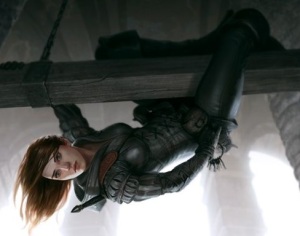Cover art by Jason Chan
Widdershins adj. in a direction contrary to the natural one. —Dictionary.com
I’ve been mildly in love with this novel cover by Jason Chan ever since I saw it on Pintrest a while back. The image is from the cover of Thief’s Covenant by Ari Marmell. I’ve not read Thief’s Covenant, unfortunately, and I’m only passingly familiar with Ari’s work. From what I’ve learned, it’s a story about a noble girl forced to flee into the city’s dark underbelly after the murders of her family. She becomes part of a thieves’ guild under the alias “Widdershins” (which is the coolest fantasy character name since Finarfin from Tolkien’s Silmarillion).
Given the dark, hooded outfit, I think the argument could be made that Widdershins’s apparel comes across as the archetypical (or even cliche) fantasy thief’s outfit. And I’d agree that our agile brunette here is hardly the first burglar in literature to opt for a black leather catsuit. But one thing I try to remind myself about the archetypical is that often something becomes an archetype because it’s a smart way to operate. And I feel like Widdershins has a smart, practical outfit for someone in her profession.
First off, I appreciate that Widders’s outfit covers all of her—no bare midriffs, gratuitous cleavage, or superfluous slits in the pant-legs (I was going to link to an example of each of these pointless sexualizations, but I found I can cover all of them with one picture of Halle Berry’s Catwoman).
I like the soft leather: its  an all-around effective compromise in flexibility and protectiveness. I find matte-black leather to be an interesting trade-off from black cloth. While black linen or cotton is lighter and more flexible as well as less reflective than even suede leather—and thus less likely to shine in the torchlight—leather has the definite advantage in durability. In particular, the leather holds up better for scaling walls, shinnying up rain spouts, or dangling from rafters. In addition, leather is more protective should our heroine find herself in a scuffle with the night watchmen. In a way I think the leather helps to highlight her status as a burglar, rather than a thief or pickpocket.
an all-around effective compromise in flexibility and protectiveness. I find matte-black leather to be an interesting trade-off from black cloth. While black linen or cotton is lighter and more flexible as well as less reflective than even suede leather—and thus less likely to shine in the torchlight—leather has the definite advantage in durability. In particular, the leather holds up better for scaling walls, shinnying up rain spouts, or dangling from rafters. In addition, leather is more protective should our heroine find herself in a scuffle with the night watchmen. In a way I think the leather helps to highlight her status as a burglar, rather than a thief or pickpocket.
Widdershins’s choice of long boots instead of soft calf-lengths or even shoes is an intriguing one. Where lighter footwear is quieter, her boots are more durable for running or climbing, plus she can unroll them to wade moats or sewers to infiltrate her target manse or estate. Plus, though we can’t tell from this picture, they aren’t stupid high-heels. I like, too, that she wears full gloves, rather than a thief’s fingerless ones, to protect her hands when climbing metal fences or coarse, stone walls. I think both boots and gloves help further establish her as part of the breaking-and-entering trade, rather than mugging or pickpocketing.
I like her accessories, as well. Her hood keeps her face partly hidden and allows her larceny on rainy nights. Her sword is handy for if she finds herself in an altercation with the constables—I suspect it must be tied or clipped into its scabbard if she’s able to hang upside down without it falling. The keyring of lockpicks is a nice touch, though I’d recommend that she wrap it in cloth while not using it, as they tend to jangle. I count at least three pouches on Widders’s belt, likely containing the countless tools of her trade. Small pry-bars, strings, wires, acids, ether, oils for greasing rusty locks or hinges, even black powder and smoke bombs if time-period appropriate: I wouldn’t be surprised to find any of these in her pouches.
One last comment I’ll make on Widdershins’s attire is that it is timeless. It would be thematically appropriate in any number of assumed time periods, from medieval to Renaissance to colonial to Napoleonic. (I’m not actually certain on the story’s assumed time period. The creased shoulders suggest late-medieval or Renaissance, but don’t necessitate either time period.) Regardless, it comes across as all-around effective rogue’s apparel. Excellent work once again, Jason.

